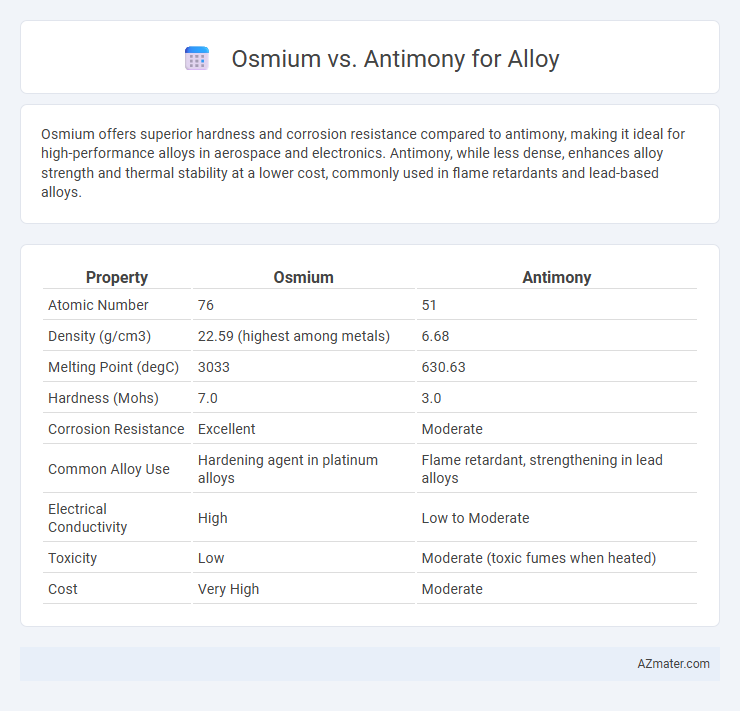Osmium offers superior hardness and corrosion resistance compared to antimony, making it ideal for high-performance alloys in aerospace and electronics. Antimony, while less dense, enhances alloy strength and thermal stability at a lower cost, commonly used in flame retardants and lead-based alloys.
Table of Comparison
| Property | Osmium | Antimony |
|---|---|---|
| Atomic Number | 76 | 51 |
| Density (g/cm3) | 22.59 (highest among metals) | 6.68 |
| Melting Point (degC) | 3033 | 630.63 |
| Hardness (Mohs) | 7.0 | 3.0 |
| Corrosion Resistance | Excellent | Moderate |
| Common Alloy Use | Hardening agent in platinum alloys | Flame retardant, strengthening in lead alloys |
| Electrical Conductivity | High | Low to Moderate |
| Toxicity | Low | Moderate (toxic fumes when heated) |
| Cost | Very High | Moderate |
Overview of Osmium and Antimony
Osmium is a dense, hard transition metal with exceptional corrosion resistance and high melting point, making it valuable for strengthening alloys and enhancing durability. Antimony is a metalloid known for its brittleness and ability to improve the hardness and mechanical properties of alloys, often used in lead-acid batteries and flame retardants. When alloyed, osmium contributes to wear resistance and longevity, while antimony adds rigidity and structural integrity, influencing the overall performance of the material.
Atomic Structure and Properties
Osmium and antimony differ significantly in atomic structure and properties, influencing their alloy applications. Osmium, with an atomic number of 76, has a dense hexagonal close-packed (hcp) crystal structure, resulting in exceptional hardness and high melting point ideal for durable alloys. Antimony, atomic number 51, possesses a layered rhombohedral structure, offering brittleness and low thermal conductivity, typically enhancing alloy hardness and corrosion resistance when combined with other metals.
Occurrence and Extraction
Osmium is a rare platinum-group metal primarily obtained as a byproduct of nickel and copper refining in regions like the Ural Mountains and South Africa, extracted via complex electrolytic and chemical processes due to its density and chemical inertness. Antimony, more abundant and commonly found in sulfide ores such as stibnite, is extracted through roasting and reduction techniques in countries including China, Bolivia, and Russia. The distinct geological occurrence and extraction methods influence their availability and cost-effectiveness in alloy production.
Alloying Behavior and Compatibility
Osmium exhibits exceptional hardness and corrosion resistance, making it highly effective in enhancing the durability and wear resistance of alloys, particularly in high-performance applications. Antimony, known for its ability to improve hardness and mechanical strength, is widely used in alloys to increase brittleness and oxidation resistance, notably in lead and tin alloys. Osmium's high melting point and dense atomic structure limit its solubility and compatibility with many metals, whereas antimony's metalloid nature allows better alloying flexibility and compatibility with a broader range of base metals.
Mechanical Strength and Hardness
Osmium exhibits exceptional mechanical strength and hardness, making it one of the densest and most durable metals suitable for high-performance alloy applications. In comparison, antimony offers moderate hardness and tensile strength but is primarily valued for its ability to improve resistance to corrosion and wear rather than contribute substantial mechanical reinforcement. Alloys containing osmium provide superior hardness and strength, ideal for cutting tools and wear-resistant components, while antimony is often used in alloys to enhance stability and reduce brittleness.
Corrosion and Oxidation Resistance
Osmium exhibits exceptional corrosion resistance and oxidation stability due to its dense atomic structure and high melting point, making it ideal for extreme environments in alloy applications. In contrast, antimony offers moderate corrosion resistance but is more prone to oxidation, limiting its effectiveness in harsh or high-temperature conditions. Alloys incorporating osmium generally achieve superior durability and longevity compared to those with antimony, especially where resistance to chemical degradation is critical.
Thermal and Electrical Conductivity
Osmium exhibits superior thermal and electrical conductivity compared to antimony, making it ideal for alloys requiring efficient heat and electrical transfer. Antimony, with lower conductivity, primarily enhances alloy strength and hardness rather than conductive properties. Alloys with osmium provide better performance in high-temperature and electrical applications due to osmium's robust metallic bonding and electron mobility.
Common Alloy Applications
Osmium and antimony are both valuable alloying elements but serve distinct purposes; osmium is primarily used in hardening platinum and iridium alloys for electrical contacts and fountain pen tips due to its extreme density and hardness. Antimony is frequently incorporated in lead alloys to improve hardness and mechanical strength, especially in battery grids, type metal, and solders. Common alloy applications exploit osmium's durability for precision instruments, while antimony enhances wear resistance and corrosion control in everyday metal products.
Environmental and Health Concerns
Osmium and antimony differ significantly in environmental and health impacts when used in alloys. Osmium, particularly in its volatile oxide form, osmium tetroxide, poses toxicity risks to respiratory and ocular systems, requiring strict handling precautions during alloy processing. Antimony, often found in fire retardants and alloys, can release harmful dust and fumes causing respiratory irritation and potential cardiovascular effects, but it is generally less volatile and easier to manage in industrial applications.
Cost and Market Availability
Osmium is significantly more expensive than antimony due to its rarity and complex extraction process, limiting its use primarily to specialized applications. Antimony is more abundant and widely available on the global market, making it a cost-effective choice for alloy manufacturing. Market availability and lower price points make antimony the preferred element for industries requiring economical alloy solutions.

Infographic: Osmium vs Antimony for Alloy
 azmater.com
azmater.com